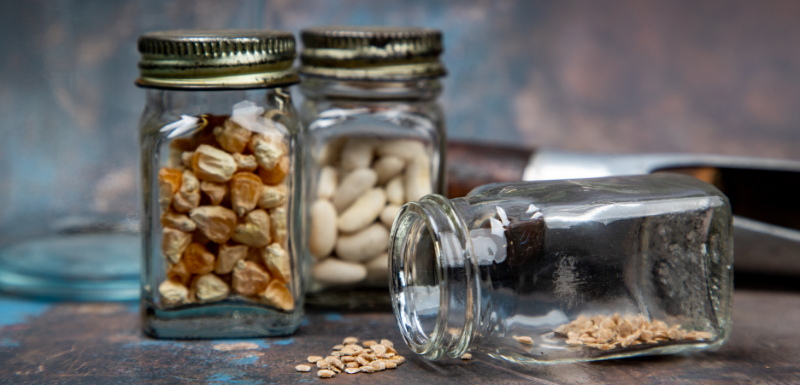Introduction
In a world grappling with environmental challenges and the need for sustainable practices, the preservation and sharing of seeds have emerged as crucial strategies for cultivating resilient food systems. Seed saving, the age-old practice of collecting and preserving seeds from one season to the next, empowers communities to safeguard their agricultural heritage and adapt to changing conditions. Moreover, the act of sharing seeds fosters collaboration, knowledge exchange, and biodiversity conservation. In this blog, we will explore the significance of seed saving and sharing, and how they contribute to the development of resilient food systems.
The Importance of Seed Saving
Seed saving is an integral part of human history, as ancient farmers relied on it to sustain their crops for generations. However, with the advent of industrialized agriculture and the commercialization of seeds, traditional seed saving practices were marginalized. Today, the reemergence of seed saving is seen as a means to restore our connection with nature, strengthen food security, and mitigate the risks associated with monoculture farming.
Genetic Diversity and Adaptability
Saving seeds helps maintain genetic diversity in plant populations. Unlike commercially available hybrid seeds, saved seeds are open-pollinated and possess a wide range of traits that can adapt to local conditions. This diversity increases the resilience of crops, enabling them to withstand pests, diseases, and extreme weather events. By preserving traditional varieties, farmers safeguard invaluable genetic resources that may hold the key to future challenges in agriculture.
Cost-Effectiveness and Independence
Seed saving reduces farmers’ dependency on purchasing seeds each season, making agriculture more cost-effective and sustainable. Instead of relying on seed companies, farmers can retain control over their seeds, selecting and saving those that perform well in their specific environment. This independence empowers farmers, particularly in marginalized communities, to build self-reliant food systems and protect their livelihoods.
The Power of Seed Sharing
While seed saving ensures the continuity of local varieties, sharing seeds extends the benefits of this practice beyond individual farmers. Seed sharing involves the exchange of seeds among farmers, communities, and organizations, fostering collaboration and knowledge transfer. Here are some key advantages of seed sharing:
Community Building and Cultural Preservation
Seed sharing events and networks provide a platform for farmers and gardeners to come together, strengthening community bonds. Sharing seeds often entails sharing knowledge, stories, and experiences associated with specific varieties, thus preserving cultural heritage and traditional farming practices. This process not only enhances social cohesion but also empowers individuals by reconnecting them with their food and cultural roots.
Enhancing Biodiversity
The exchange of seeds diversifies local plant populations, ensuring a wider range of genetic traits. As farmers share seeds, they contribute to the preservation of heirloom and indigenous crop varieties that might otherwise be lost. This increased biodiversity strengthens ecosystems, supports pollinators, and mitigates the risks associated with monoculture, such as susceptibility to pests and diseases.
Adapting to Changing Environments
Seed sharing facilitates the dissemination of climate-resilient crop varieties. Farmers facing similar climatic challenges can exchange seeds that have demonstrated adaptability to particular conditions. By sharing experiences and successes, communities can collectively adapt to changing environments, ensuring the long-term productivity and sustainability of their food systems.
Conclusion
Seed saving and sharing are essential components of building resilient food systems in a rapidly changing world. Through seed saving, farmers maintain genetic diversity, adaptability, and independence in their agricultural practices. Seed sharing amplifies these benefits by fostering community collaboration, preserving cultural heritage, and enhancing biodiversity. By embracing these practices, individuals and communities contribute to the conservation of traditional crop varieties and the development of sustainable farming systems that are better equipped to withstand environmental uncertainties. Let us recognize the value of seeds as more than just a means to produce food but as living repositories of knowledge, resilience, and hope.
As consumers, we can actively participate in supporting seed saving and sharing initiatives. By choosing to purchase and grow open-pollinated, heirloom, or locally adapted seed varieties, we contribute to the demand for diverse and sustainable agriculture. Additionally, engaging with local seed libraries, community seed swaps, or seed-saving workshops allows us to learn from experienced seed savers and become part of a larger movement toward resilient food systems.
Furthermore, policymakers and agricultural institutions play a critical role in promoting seed saving and sharing practices. They can allocate resources to support seed banks, research programs focused on local varieties, and initiatives that encourage farmer-to-farmer seed exchanges. By integrating seed-saving principles into agricultural policies, we can foster an environment that values and supports the conservation of plant genetic resources.
It is important to acknowledge that seed saving and sharing alone cannot solve all the challenges faced by our food systems. However, they offer a tangible and empowering starting point. These practices not only preserve traditional knowledge but also foster innovation and adaptation. By embracing the diversity of seeds and engaging in collaborative efforts, we can cultivate resilient food systems that are better prepared to navigate climate change, disease outbreaks, and other environmental uncertainties.
In conclusion, the seeds of change lie within our hands. Through the ancient practice of seed saving and the power of seed sharing, we have the opportunity to transform our food systems into models of sustainability, diversity, and resilience. Let us embrace the beauty and potential of seeds as we cultivate a future where our relationship with food and nature is nurtured, sustained, and enriched. Together, we can sow the seeds of change and harvest a bountiful and resilient world for generations to come.








